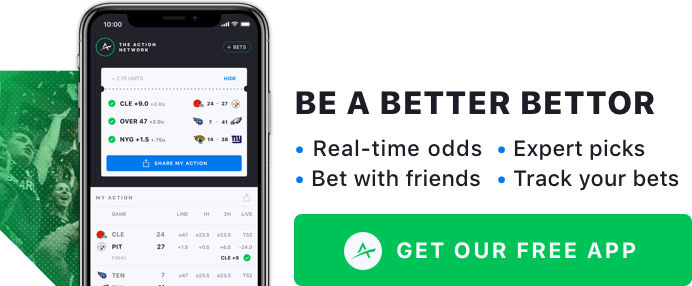Week 3 of the XFL is here.
While it is tempting to draw conclusions based on the data we’ve gathered through two weeks, it’s important to remember that we are still dealing with small samples and the league’s offenses will continue to evolve.
With that in mind, I’m taking a look at four wide receivers who over- or underperformed expectations in Week 2 and projecting the production we can anticipate in the coming weeks.
For more high-level analysis, check out Matthew Freedman’s team rankings moving into Week 3.
Odds as of Wednesday morning and via FanDuel, where Action Network users get a risk-free bet up to $500.
Tampa Bay Vipers WR Daniel Williams
In Week 1, Williams looked like a true alpha receiver as he played every snap and racked up nine targets and a 6-123-0 receiving line.
In Week 2, Williams played only 59% of team snaps while splitting time with Seantavius Jones, who saw the field on 27-of-73 snaps after failing to play a single snap in Week 1 (per Pro Football Focus). Opposite Williams, starting wide receiver Jalen Tolliver also saw reduced playing time, dropping from 97% in Week 1 to 66% in Week 2, with the majority of those vacated snaps going to Tanner McEvoy.
The receiver usage splits in Tampa Bay are hard to predict with so much uncertainty in the offense. Week 1 starting quarterback Aaron Murray (foot) missed Week 2, so backup Taylor Cornelius — a ninth-found selection in the skill player draft — got the start.
It’s possible that McEvoy and Jones had a better rapport with Cornelius in practice because of their together at second-stringers, and when the Vipers were forced to start their backup quarterback, they decided to give his favored receivers more playing time. To that point, Jones led the team in air yards last week and was targeted four times in the fourth quarter with the team in comeback mode.
Jones also has draft capital on his side — if such a thing exists in the XFL — after being selected No. 12 overall in the skill player draft this offseason.
Fantasy Takeaway: Without further clarity on Jones’ role in the offense, it will be hard to roster Williams in Week 3 at his elevated salaries of $8,200 on DraftKings and $16 on FanDuel.
Houston Roughnecks WR Sammie Coates
In 2016 — Coates’ only NFL season with 100-plus receiving yards — he finished in the bottom five with a 42.9% catch rate (per Pro Football Reference). Four years later, Coates is still an inefficient receiver. Despite playing with quarterback P.J. Walker, arguable the league’s best passer, Coates has converted 13 targets into three receptions for 34 yards through two games.
The Roughnecks’ patience with Coates might be wearing thin.
A target hog through the first six quarters of the season, Coates was not targeted past the 8:50 mark of the third quarter in Week 2, and his snap share was down 10% percent from Week 1. Nick Holley appears to be the biggest beneficiary of Coates’ benching, as the running back/wide receiver played on 89% percent of Houston’s snaps, up from 66% in Week 1.
Initially listed as a running back on Houston’s depth chart, Holley played quarterback, running back and wide receiver in college but is small (5-foot-10, 194 pounds) and slow (4.71-second 40-yard dash). You wouldn’t think he would be the kind of guy to steal snaps from Coates, who posted a 99th percentile SPARQ-x score entering the NFL, but at least Holley can catch the ball.
Fantasy Takeaway: Coates will likely still see significant playing time, but he will need to prove himself to be a reliable option in the offense before he can be rostered with confidence.
Where is online sports betting legal?
New York Guardians WR Joe Horn Jr.
Horn racked up 105 air yards on a 29% target share in Week 1,so he was a popular bounceback candidate in Week 2, but he failed to deliver, finishing with only six receiving yards on three targets.
Horn’s snap share fell from 78% to 56% in Week 2, with Teo Redding and Austin Duke picking up most of Horn’s vacated snaps. Redding was a buzzy name this offseason after reportedly having a strong camp, but he played only three snaps in the season opener. The primary return man for the Guardians, Duke saw no offensive action in Week 1, but the team evidently liked his big-play ability enough to give him 15 snaps in Week 2.
It’s important to remember that the Guardians are currently without starting wide receivers DeAngelo Yancey and Tanner Gentry, both of whom are on short-term injured reserve and tentatively expected to return at some point. Yancey and Gentry were the team’s first- and third-round selections in the skill player draft.
Fantasy Takeaway: With Mekale McKay the lone starting receiver in three-wide sets, the Guardians will likely deploy a hot-hand or platoon approach opposite McKay in the receiving game, making Horn a boom/bust option with zero-point downside.
Seattle Dragons WR Keenan Reynolds
With an absurd 50% target share in Week 2, Reynolds was the lone bright spot in a Dragons aerial attack that produced only 91 yards passing against the Vipers. While Reynolds should continue to be featured in the Dragons offense, there are reasons to temper expectations.
For starters, Week 1 target magnet Austin Proehl disappointed in Week 2, finishing with -1 receiving yards after posting a 5-88-2 receiving line in the opener. The Dragons passed at a much lower rate — 18 total pass attempts vs. 40 in Week 1 — but Proehl’s target share remained intact. If Proehl bounces back next week, he will likely cut into Reynolds’ production.
Additionally, ex-CFL standout S.J. Green has been linked to the Dragons after securing his release from the Toronto Argonauts earlier this month. At one time, the XFL transactions page noted that Green was signed by Seattle, but that record has since been deleted. In the CFL, Green exceeded the 1,000-yard mark seven times and could potentially cut into Reynolds’ target share if he truly has signed with the team.
Fantasy Takeaway: Reynolds will have a prominent role in the offense no matter what, but keep an eye on Green’s status moving forward.
UPDATE (Feb. 18): The Dragons have reportedly traded Green to the Vipers.
Pictured: Sammie Coates
Credit: Bob Levey/Getty Images



